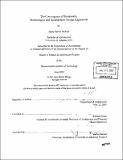The convergence of sustainable technologies and architectural design expression
Author(s)
Phillips, Jason Patrick, 1973-
DownloadFull printable version (23.84Mb)
Other Contributors
Massachusetts Institute of Technology. Dept. of Architecture.
Advisor
William Porter.
Terms of use
Metadata
Show full item recordAbstract
In recent years an unprecedented ecological awareness has taken hold, not only within the discipline of architecture, but throughout our society as well. No longer are we, as a culture, accepting of the long established traditions of buildings holding dominion over nature at all cost and without consequence. Today there is concern with bringing mankind and all things manmade into a benign harmony with our natural environment. Architects can no longer be content with simply satisfying basic requirements of health, safety and welfare in their buildings. More esoteric investigations into the poetics of space, theoretical experimentation, or symbolic reference also are not enough. A new layer of expertise and understanding is now required of our discipline. The pursuits of design expression must now work in tandem with the advancement of sustainable technologies to achieve an architecture that responds in a positive and sensitive way to the environment in which it resides. Sustainable issues have become a significant participatory, yet not dominate, element within architectural design. It is the position of this thesis that there is a recent- and widespread--convergence of sustainable technologies and design expression that is occurring and affecting the entire discipline of architecture. The logical synthesis of technology and design is fundamentally altering not only what is built, but also how it is built. The physical implications of this convergence on contemporary architecture are that it is creating a new formal vocabulary never seen before. In many cases, a new typology is emerging. This thesis is primarily focused on identifying the physical architectural evidence associated with this convergence. The physical manifestation of the synthesis of sustainable technologies and design expression can be seen in a wide range of projects throughout the discipline and is bound by no aesthetic or formal category. These concerns have seemingly transcended all formal categorization, and are affecting architecture regardless of function, style, or theoretical position. Whereas once sustainability was relegated to its own category, today it has become apart of all categories. It is important to identify this phenomenon; understand how it is affecting the discipline of architecture; and to realize where the industry is going as a result.
Description
Thesis (S.M.)--Massachusetts Institute of Technology, Dept. of Architecture, 2003. Includes bibliographical references (leaves 114-119).
Date issued
2003Department
Massachusetts Institute of Technology. Department of ArchitecturePublisher
Massachusetts Institute of Technology
Keywords
Architecture.